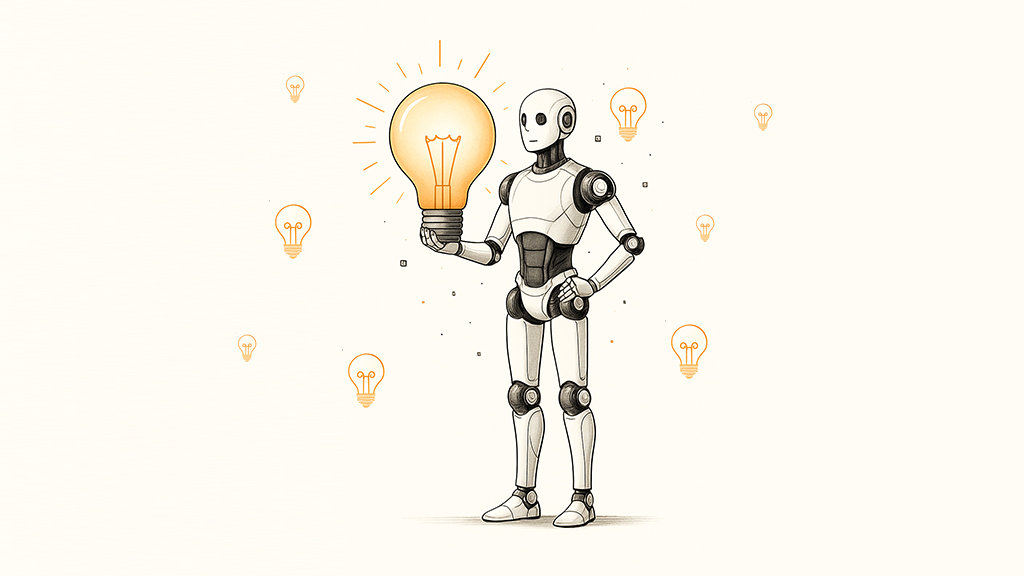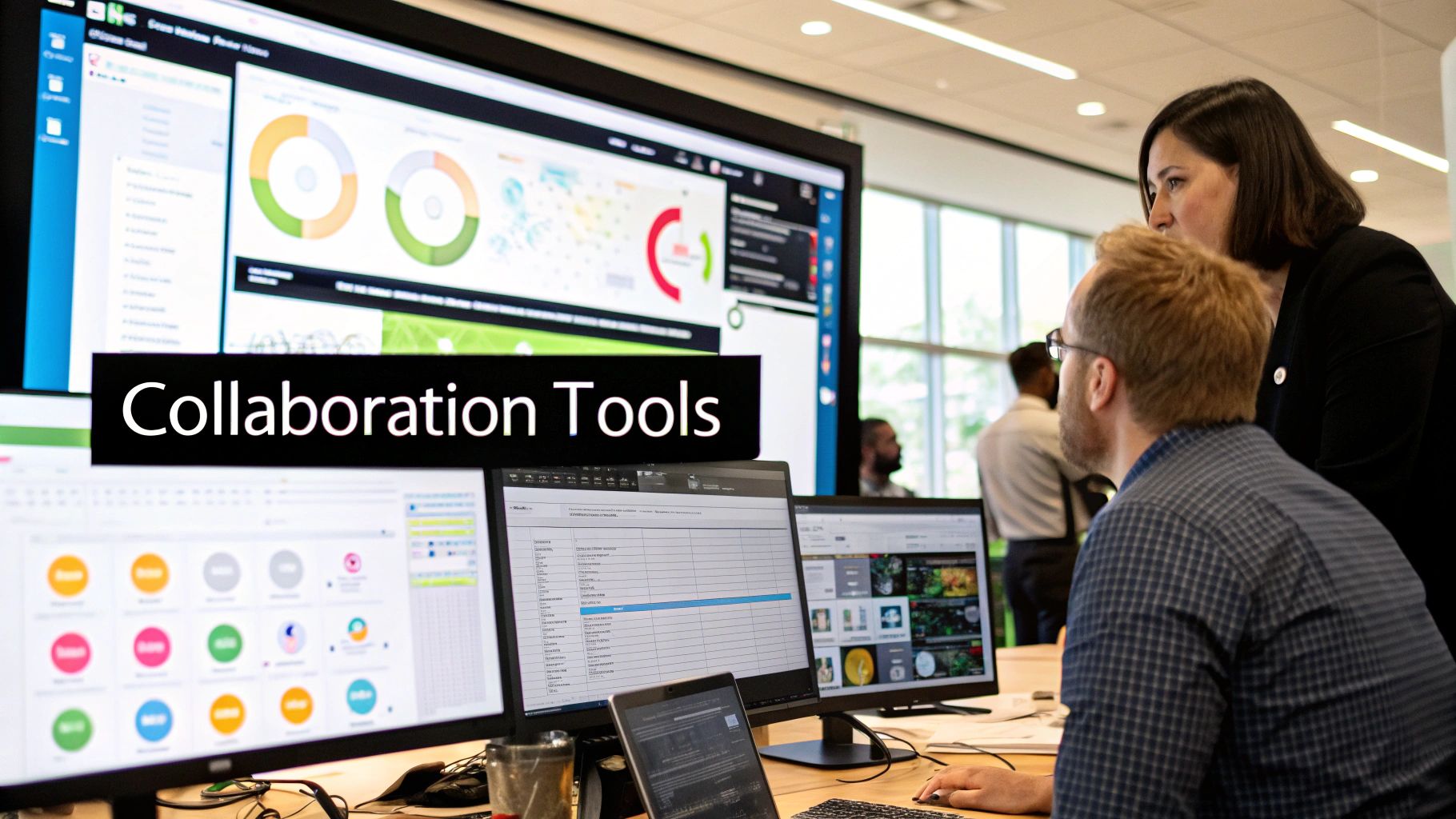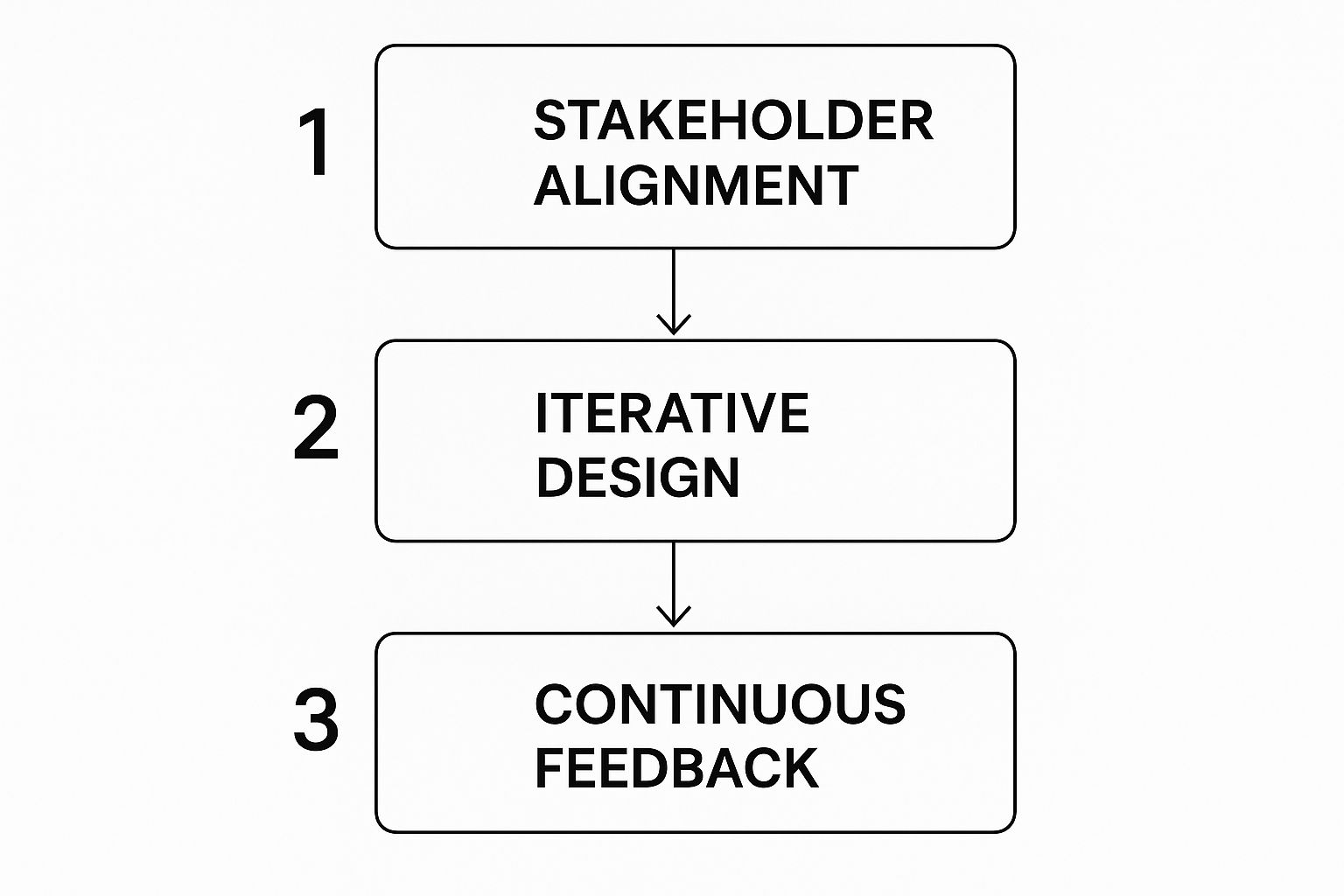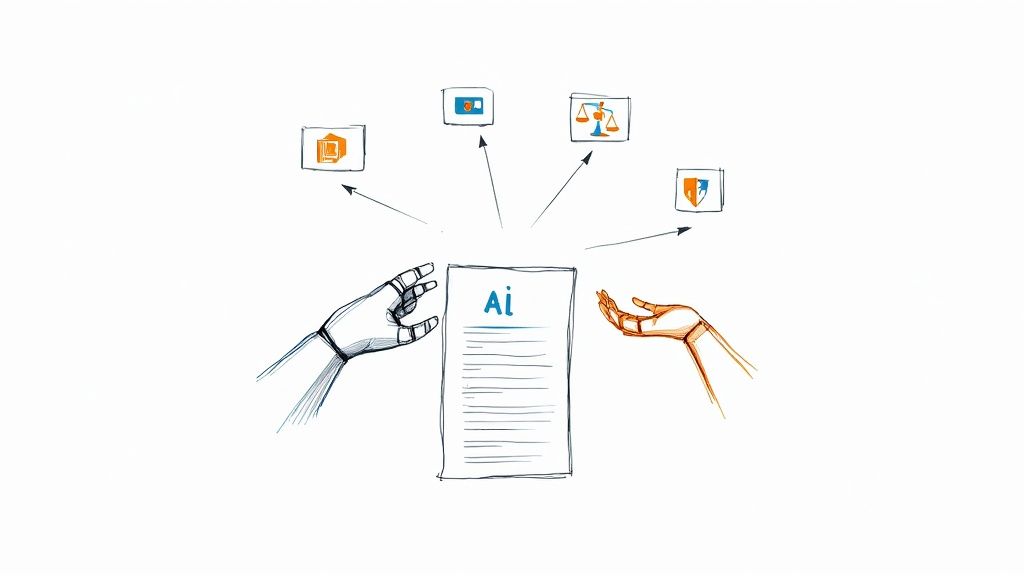Master Co-Creating AI Solutions for Innovation
Learn how to co-create AI solutions effectively. Our guide offers practical tips and real-world examples to drive successful AI collaboration.

Let's get one thing straight: the most impactful AI isn't built in a vacuum by a handful of developers. The idea of a lone genius coding away in a dark room is a myth. Truly effective AI solutions are born from something far more dynamic: co-creation.
This is all about bringing a mix of people to the table—developers, business leaders, subject-matter experts, and even the end-users themselves—to jointly design and build systems that tackle genuine, real-world challenges.
How Co-Creating AI Changes Everything
Imagine trying to produce a blockbuster film. You wouldn't just hire a special effects guru and hope for the best. A masterpiece needs a director's vision, the actors' performances, and the technical crew's expertise in sound and lighting, all working in perfect harmony. Without that synergy, you might end up with dazzling visuals in a movie with no story.
It's the same with AI. Successful AI co-creation isn't just about the code. It’s about building a shared understanding from day one, which dramatically lowers the risk of project failure and ensures the final product delivers real business value. This collaborative spirit turns AI from a siloed, technical experiment into a true engine for innovation and growth.
More Than Tech, It's a Shared Vision
 The old way of building AI was often a one-way street. A business leader would identify a problem, toss it over the wall to a tech team, and wait for a finished product to emerge. This is a recipe for disaster. More often than not, it results in tools that are technically brilliant but completely impractical, failing to solve the very problem they were designed for.
The old way of building AI was often a one-way street. A business leader would identify a problem, toss it over the wall to a tech team, and wait for a finished product to emerge. This is a recipe for disaster. More often than not, it results in tools that are technically brilliant but completely impractical, failing to solve the very problem they were designed for.
Co-creation turns that entire process upside down. It works from the belief that the best solutions come from the intersection of different viewpoints. By getting everyone involved, from the boardroom to the factory floor, you ground your AI initiatives in the practical realities of your business.
This is the absolute cornerstone of good AI strategy consulting, where the entire point is to marry what’s technologically possible with what’s strategically vital. The conversation shifts from "what cool thing can we build?" to "what should we build to make a meaningful difference?"
Co-creation thrives on collective intelligence. It's a simple acknowledgement that the people who live and breathe the problem every day—your users and domain experts—are the ones who hold the secrets to building a solution that actually works.
Laying a Foundation for Success
When you embrace co-creation, you're not just changing a process; you're changing your company's culture. Innovation is no longer a single, high-stakes event. Instead, it becomes a continuous loop of building, testing, and refining based on constant, real-world feedback.
This way of working delivers some powerful advantages:
- Drastically Reduces Risk: Catching flaws, hidden biases, or operational roadblocks early on saves a huge amount of time and money down the line.
- Speeds Up Adoption: When people help build a tool, they feel a sense of ownership. They become its biggest champions, which makes rollout infinitely smoother, as we explored in our AI adoption guide.
- Maximises Business Value: Every single feature is directly linked to a specific business need, ensuring you get the best possible return on your investment.
Ultimately, this collaborative approach brings AI down to earth, transforming it from an abstract concept into a practical tool shaped by the very people who depend on it. To see how this can be put into practice, it's worth exploring an AI strategy framework that has these principles baked in. By bringing everyone together, co-creation builds AI that doesn't just function—it flourishes.
Why Bother with Co-Creation for AI? The Business Case is Clear

So, why are so many forward-thinking companies switching to a collaborative model for building AI? The answer isn't just about feeling good—it's about getting real, measurable business results. The biggest gain is simple: you build AI that people actually want and need, ensuring your investment pays off.
When you bring end-users, subject-matter experts, and other stakeholders into the fold right from the start, you avoid a classic tech pitfall: creating a tool that's technically impressive but practically useless. It's a surefire way to accelerate innovation and, just as importantly, boost adoption.
Think about it. When people have a hand in creating a solution, they become its natural champions. This makes the rollout smoother and gets people using the tool from day one, which is absolutely vital for seeing a return on any new technology.
From Averting Disasters to Boosting Your Bottom Line
At its heart, co-creation is a brilliant risk-management strategy. It helps you spot potential biases, operational headaches, and user-experience flaws long before they become expensive, project-sinking failures. It’s like having a built-in quality assurance team, powered by the very people who will depend on the system.
As customers increasingly expect more personalised services, a collaborative AI strategy framework isn't just a nice-to-have; it's essential. It gives you a roadmap to make sure every single feature directly serves key business goals and drives up your return on investment.
This is particularly true in fast-growing markets. For example, the AI market in the Netherlands is on track to grow at a blistering 26.21% annually between 2025 and 2031, hitting a market volume of US$9.64 billion. This boom is being driven by both businesses and consumers who demand smarter, more efficient services. That’s a huge opportunity for companies that get co-creation right.
Solo Development vs Co-Creation Approach
To really grasp the difference this makes, let's compare the old-school, siloed way of developing AI with the modern, co-creative approach. The gap in outcomes is striking and speaks volumes about a project's chances for long-term success.
Aspect
Solo AI Development
AI Co-Creation
User Adoption
Often low due to a disconnect between the tool and user needs.
High, as users feel a sense of ownership and the tool is built for them.
Project Risk
High, with potential for budget overruns and timeline delays.
Low, as issues are identified and addressed early and often.
Innovation
Limited by the perspective of a small, isolated technical team.
Accelerated by combining diverse expertise and real-world insights.
Business Alignment
Can easily drift from strategic goals, creating a "solution in search of a problem."
Always aligned with business value, ensuring a clear path to ROI.
Flexibility
Rigid, making it difficult to adapt to new information or changing needs.
Agile and iterative, allowing for continuous refinement and improvement.
As the table shows, while going it alone might seem quicker at first glance, co-creating ai solutions consistently leads to better, more sustainable results. The focus shifts from just building a product to building the right product.
The core advantage of co-creation is simple: it ensures you are solving the right problem for the right people, in the right way. This alignment is the single most important factor in determining the success of any AI initiative.
By adopting this collaborative mindset, organisations don’t just end up with better technology. They cultivate a more resilient, innovative culture. The process itself builds a shared understanding and collective buy-in that transforms AI from a high-stakes gamble into a predictable engine for business growth.
The Ground Rules for Successful AI Co-creation

Truly effective co-creating AI solutions doesn’t just happen. It’s built on a set of core principles that act as a blueprint for success. Without this foundational philosophy, even the most promising AI project can drift off course. Honing these principles, often with guidance from professional AI strategy consulting, is what truly separates the projects that take off from those that never get off the ground.
This collaborative mindset moves far beyond old-school development methods, creating a culture where everyone has skin in the game. Let's look at the three pillars that hold up any successful co-creation effort.
Bring Everyone to the Table
First and foremost, you need inclusive participation. This isn't a buzzword; it's about deliberately bringing a wide mix of people into the conversation right from the start. Your goal is to assemble a team that reflects every single angle of the problem you're aiming to solve.
That means looking beyond the boardroom and the server room. You need the people from the front lines—the engineers on the factory floor, the agents handling customer calls, the sales team in the field. Their day-to-day experience is pure gold. A 2024 symposium by Microsoft and the American Federation of Teachers drove this point home, concluding that the expertise of end-users (in their case, teachers) is absolutely essential to making AI work for real people.
Here’s how to make it happen:
- Map Your Stakeholders: Make a list of every single group that will interact with the AI, from development to daily operation.
- Empower Your Experts: Give your subject-matter specialists a genuine say in the design process, not just a ceremonial seat at the table.
- Keep Communication Open: Create straightforward channels for feedback so everyone’s insights can be shared, heard, and acted upon.
Create a Shared Language
The second pillar is building a shared language. So many tech projects get derailed because the technical and business teams are speaking past each other. Developers might be focused on APIs and model accuracy, while business leaders are thinking about ROI and market share. Without a common vocabulary, you're building a tower of Babel.
Creating this shared language is vital for getting everyone aligned. It’s about using clear analogies and straightforward terms to demystify complex AI concepts. When the CEO and the lead data scientist both understand the project's goals, capabilities, and—just as importantly—its limitations, you're on the right track.
It's a bit like a sports team. The coach, players, and medical staff all need to understand the same playbook to win. In AI co-creation, your shared language is that playbook, ensuring every person is working toward the same goal.
A solid AI strategy framework gives you a structure for these conversations. It helps translate business aims into technical requirements and technical progress into business impact, creating the common ground needed for real collaboration. This ensures that when you dive into an AI requirements analysis, everyone is starting from the same definition of success.
Build, Test, and Learn—Endlessly
Finally, successful co-creation thrives on iterative prototyping. The old "waterfall" approach—spending months or years building a perfect, finished product in a vacuum—is a recipe for failure in the fast-moving world of AI. Instead, you need to adopt a "build-measure-learn" cycle.
Start small. Develop a simple prototype or a Minimum Viable Product (MVP). This first version isn't supposed to be flawless; its entire purpose is to get something functional into the hands of real users as fast as possible. This agile method is a core feature of modern AI strategy consulting tool platforms, which are all about rapid testing and validation.
This cycle gives you a powerful rhythm:
- Build a basic, tangible version of your idea.
- Measure how it performs and, crucially, gather direct feedback from people using it in their actual work.
- Learn from that feedback to refine, improve, or even completely rethink your approach for the next version.
This constant feedback loop is what makes the final solution so robust. By testing ideas against real-world use cases, you ensure the AI tool you're building is constantly evolving to solve the problems it was actually designed for, guided by the very people who need it most.
A Practical Framework for Co-Creating Your AI Solution
So, how do you take co-creation from a good idea and turn it into something that actually works? You need a framework. This isn't a rigid, step-by-step manual, but more of a flexible roadmap to guide your collaborative journey. By breaking the process down, you can make sure every voice gets heard, every good idea is on the table, and the final result genuinely helps your business.
The whole point is to move from big, broad ideas to focused, concrete action. Let's walk through the key stages of a practical approach to co-creating AI solutions.
Stage 1: Discovery and Alignment
Every great AI project starts with a conversation, not a line of code. The first job is to get everyone on the same page and truly understand the problem you're trying to solve. This means getting all the key people in a room (or a virtual one)—from the C-suite and IT specialists to the people who will actually use the tool every day.
Collaborative workshops are your best friend here. These aren't just meetings; they're designed to dig past the surface-level assumptions and get to the heart of the business challenge. You want to walk out of this stage with a crystal-clear problem statement and a set of measurable goals that everyone agrees on. We cover how to run these sessions effectively in our guide on facilitating an effective AI workshop.
Stage 2: Ideation and Design
Once you have that shared vision, it’s time to get creative and explore what’s possible. This stage is all about brainstorming and mapping out potential solutions. Using tools like virtual whiteboards, teams can throw ideas around freely without worrying about getting it perfect right away.
The focus here is on mapping out the user journey. How will someone actually interact with this AI? What are the most important touchpoints? By visualising these pathways, an abstract idea starts to feel real. This collaborative design process makes sure the solution is built around the user from the very beginning, not as an afterthought.
This infographic captures the rhythm of the co-creation process, showing the flow from initial agreement to continuous improvement.

As you can see, a successful project isn’t a straight line. It's a cycle where feedback constantly refines the design and keeps everyone aligned.
Stage 3: Prototype and Validate
This is where your ideas start to take shape. The technical team steps in to build a Minimum Viable Product (MVP). Think of an MVP as a simple, working version of your AI solution—it has just enough features to be useful and to start gathering honest feedback.
This is a critical moment where business ideas get translated into technical specs. The goal isn't perfection. It’s about building something real that you can put in front of users to see how it performs in the wild.
Stage 4: Iterate and Refine
With the MVP in the hands of users, the feedback loop kicks into high gear. This stage is all about listening. Is the tool easy to use? Does it actually solve the problem you thought it would? What unexpected issues or opportunities are popping up?
This back-and-forth cycle is the engine of co-creation. It turns development from a one-way street into a continuous conversation, ensuring the final product is shaped by real-world experience, not just early assumptions.
Every piece of feedback, big or small, guides the next round of development. This agile approach helps the team polish features, fix what’s broken, and steadily build a better solution, dramatically lowering the risk of creating something nobody wants.
Stage 5: Scale and Integrate
After a few rounds of iteration have proven the solution’s value, it’s time to think bigger. The final stage is about preparing the AI for a full rollout across the organisation.
This means finalising the technology, making sure it can handle more users, and plugging it into your existing systems. Just as important are change management and training—you need to help your teams adapt to new ways of working to ensure the tool is widely adopted and delivers its full potential. This is the stage where all that collaborative effort truly pays off.
Real-World Examples of Co-Creation in Action
Theory and frameworks are one thing, but the real magic of co-creating AI solutions happens when you see it in the wild. To really grasp how these ideas turn into genuine results, let's look at a few powerful real-world use cases. These stories show exactly how bringing everyone to the table builds AI that actually works.
This isn't just a niche idea, either; it's a movement that's quickly gaining ground. In the Netherlands, for instance, AI adoption has skyrocketed. By 2024, 22.7% of companies with ten or more employees were using some form of AI—that's a leap of nearly nine percentage points in just one year. The trend is especially pronounced in larger companies, where 59.2% have embraced AI, signalling a clear shift towards building solutions together to find new efficiencies and spark innovation.
Manufacturing: Predictive Maintenance That People Actually Use
Picture a large manufacturing company bleeding money from unexpected machinery breakdowns. Their first instinct was to buy a ready-made predictive maintenance tool. But when they tested it, the engineers on the factory floor—the very people who needed it most—found it confusing and didn't trust its recommendations. It was a non-starter.
So, they switched gears and went for a co-creation approach. They built a team that included their data scientists, but critically, they also brought in the seasoned floor engineers and maintenance supervisors. These were the people with decades of hands-on experience, who knew the unique sounds and vibrations of each machine right before it failed. That kind of gut-level knowledge is pure gold.
The engineers weren't treated as end-users; they were treated as co-designers. Their insights into subtle operational quirks—things a standard algorithm would completely miss—were baked directly into the AI model.
What they ended up with was a predictive maintenance system that wasn't just technically sound, but also deeply trusted by the team. The engineers used it religiously because they had helped build it. They understood its logic and believed in its alerts. We’ve seen this play out time and again: when you merge technical skill with on-the-ground expertise, you get solutions that truly stick.
Healthcare: An AI Tool Built With Doctors and Patients
Here's another great example from a healthcare provider that wanted to build an AI tool to help radiologists spot early signs of disease. The goal was noble: faster, more accurate diagnoses. But the stakes were incredibly high, and the initial prototypes developed in a silo were met with a healthy dose of scepticism from the clinicians.
Wisely, they paused and launched a co-creation process. This time, the team included radiologists, nurses, and even a small group of patient advocates.
- Clinicians shaped the workflow: The radiologists mapped out their diagnostic process step-by-step, making sure the AI would assist them seamlessly rather than getting in their way.
- Nurses added practical context: They provided crucial feedback on how data is gathered in a hectic hospital environment and how alerts would need to be managed without causing more chaos.
- Patient advocates brought the human element: Their input made sure the tool's reports were framed in a way that was clear and comforting to patients, not cold and clinical.
This inclusive method, which is fundamental to our own AI strategy consulting, completely turned the project around. The final tool didn't just hit its accuracy targets; it earned the confidence of the medical staff because their own expertise was at its very heart. This kind of buy-in is non-negotiable for success. If you need help bringing a group like this together, our expert team has the experience to guide you.
Assembling Your Co-Creation Team and Toolkit
Putting the principles of co-creating AI solutions into practice takes more than just good intentions. It demands a thoughtfully assembled team and the right set of tools to make genuine collaboration happen. Think of it less like hiring for individual roles and more like casting for a film—every part is vital, and the chemistry between the players determines the success of the final production.
Success really starts with your team. This isn't a task for a single department siloed off from the rest of the business. An effective co-creation team is a cross-functional group, pulling together different perspectives to see the project from every possible angle. You'll need someone to guide the process, but the real breakthroughs happen when technical expertise meets deep, practical business knowledge.
Building Your Co-Creation Dream Team
The ideal team is a blend of different skill sets and experiences. You need people who understand the technology, the overarching business goals, and—most importantly—the day-to-day realities of the people who will actually use the solution.
Here are the essential roles you'll want to fill:
- Project Facilitator: This person is the conductor of your orchestra. They might not play an instrument, but they ensure everyone plays in harmony, keeping workshops on track and the lines of communication wide open.
- Domain Experts: These are your subject-matter specialists. They're the engineers, customer service agents, or financial analysts who live and breathe the problem you’re trying to solve. Their hands-on knowledge is simply irreplaceable.
- Technical Lead: Acting as the voice of the development team, this person brings a dose of reality to the conversation, explaining what's feasible from a tech standpoint and translating business needs into technical specifications.
- Business Stakeholder: Usually a product manager or department head, this person champions the project from a strategic level. They ensure it stays tightly aligned with business objectives and will deliver a clear return on investment.
- End-User Representatives: Involving a few people who will actually use the final AI tool is non-negotiable. They offer the kind of direct, unfiltered feedback you need to build a solution that people will genuinely want to adopt.
Piecing together a team with this mix of skills is a strategic move in itself. If you're looking for a hand in identifying the right internal experts and structuring your team for success, it can be helpful to connect with our expert team.
Equipping Your Team with the Right Toolkit
Once you have the right people, you need a digital toolkit that supports modern, agile ways of working. The aim is to create a seamless environment where ideas can be shared, debated, and fleshed out, no matter where your team members are located.
The ultimate tool is a shared mindset focused on collective problem-solving. The software and platforms are there to support and amplify that culture, not create it.
A well-rounded toolkit for co-creation usually includes:
- Communication Hubs: Platforms like Slack or Microsoft Teams are essential for keeping daily conversations organised, accessible, and transparent.
- Virtual Whiteboards: Tools such as Miro or Mural are fantastic for brainstorming sessions, mapping out user journeys, and running dynamic workshops.
- Prototyping Software: Applications like Figma or Adobe XD let your team build interactive mockups, quickly turning abstract ideas into tangible concepts that users can click through and test.
This collaborative approach is quickly becoming the norm across industries, supported by a growing ecosystem of AI tools. The Dutch AI landscape, for example, is buzzing with activity, as shown in a report that analysed over 1,200 AI-related organisations. The increasing adoption of technologies like natural language generation, which tripled in use in 2024, shows just how businesses are working together to build more sophisticated solutions. You can explore more findings from the analysis of the Dutch AI landscape on verdoold.com. By getting the right people in the room and giving them these tools, you empower your organisation to build its own co-creation muscle from the ground up.
Your Co-Creation AI Questions, Answered
As you start thinking about building AI solutions collaboratively, it's completely normal to have a few questions pop up. This approach is quite different from the old-school way of developing software, so let's walk through some of the things people often ask.
What’s the Toughest Part of Co-Creating an AI Solution?
Honestly, the biggest hurdle is rarely technical. It’s almost always about people and communication. The real challenge is getting different groups—say, the software developers and the marketing team—to speak the same language and build a space where everyone feels their input truly matters. Breaking down those classic departmental walls and keeping everyone engaged from start to finish takes real effort, a skilled facilitator, and a crystal-clear goal that everyone buys into.
How Do You Know if a Co-Created AI Project Was a Success?
Success here goes way beyond just clean code. While technical stats like model accuracy have their place, the real proof is in how the solution impacts the people and the business it was built for.
We look for a few key signs:
- High User Adoption Rates: Are people actually weaving this tool into their daily work? That’s a huge win.
- Genuine End-User Satisfaction: Do the people using the tool trust it? Do they find it genuinely helpful and easy to use?
- Clear Business Results: Did we hit the targets we set out to achieve? Think reduced operational costs, a boost in team efficiency, or happier customers.
At the end of the day, a successful project is one that delivers a tool people not only use, but rely on. It solves a real problem for real people and adds undeniable value to the business.
Is AI Co-Creation Just for Big Companies?
Not at all. Co-creation is about how you build, not how big your budget is. In fact, smaller businesses often have a natural advantage. They're typically more agile, allowing them to work very closely with their own teams and customers without the red tape you find in larger corporations. The core ideas of open dialogue and quick, iterative feedback cycles are often easier to implement in a smaller setup, letting them innovate faster and create AI tools that are a perfect fit for their specific corner of the market.
Ready to stop asking questions and start building? The journey of AI co creation is where abstract ideas become powerful, practical tools. Taking that first step is everything, and having the right people by your side can make all the difference.
Whether you're just sketching out your initial strategy or need a team to bring your vision to life, working together is the surest path to success. For practical guidance on your AI initiatives, you can always connect with our expert team.
With Ekipa AI, you can get a tailored AI strategy in just 24 hours. We help you move from idea to impact by uncovering the right use cases and providing the expert guidance needed to turn your vision into a scalable reality. Discover your AI opportunities today.



